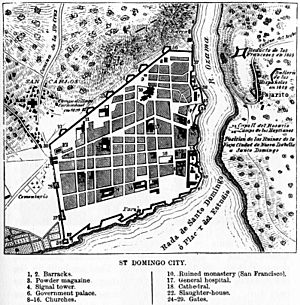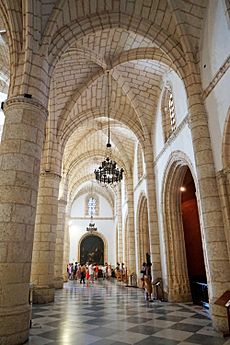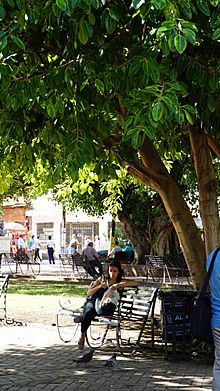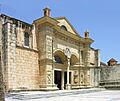Ciudad Colonial (Santo Domingo) facts for kids
Quick facts for kids
Ciudad Colonial
|
|
|---|---|
|
Historic district
|
|

Aerial view of Columbus Park in colonial district of Santo Domingo
|
|

Map of Santo Domingo, 1873
|
|
| Country | Dominican Republic |
| Province | Distrito Nacional |
| City | Santo Domingo |
| Time zone | UTC-4 |
| UNESCO World Heritage Site | |
| Official name | Colonial City of Santo Domingo |
| Location | Santo Domingo, Dominican Republic |
| Includes |
|
| Criteria | Cultural: (ii), (iv), (vi) |
| Inscription | 1990 (14th Session) |
| Area | 106 ha (0.41 sq mi) |
Ciudad Colonial (which means "Colonial City" in Spanish) is the oldest part of Santo Domingo, the capital city of the Dominican Republic. It is the very first European settlement in the Americas that has been lived in continuously since it was built.
This special area is recognized as a World Heritage Site by UNESCO. People also call it Zona Colonial (Colonial Zone) or simply "La Zona" (The Zone). It sits on the west side of the Ozama River, which flows through the city.
The Ciudad Colonial covers about 1.06 square kilometers and is surrounded by old walls. It's super important because it has many famous landmarks. These include the Alcázar de Colón, Fortaleza Ozama, and the Catedral de Santa María la Menor. Even though the main government and business areas are now in newer parts of Santo Domingo, the Colonial City is still the biggest tourist attraction.
Contents
Exploring the Past: History of Ciudad Colonial
The first settlement of Santo Domingo was started by Bartholomew Columbus (Christopher Columbus's brother) in the late 1400s. It was on the east side of the Ozama River. But after a big hurricane in 1502, the city was moved to the west side.
Nicolás de Ovando and later Diego Colón (Christopher Columbus's son) oversaw the building of the first structures. Many of these buildings are still standing today! The city's walls were very important for defense. They stretched from the Ozama River to the Puerta del Conde, which was the main entrance to the city for a long time.
The Spanish used Santo Domingo as their first base in the Americas. From here, they explored and settled other Caribbean islands and parts of the mainland. Santo Domingo was once the most important Spanish city in the New World. However, after a few decades, Spain focused more on conquering places like Mexico and Peru. Even so, Ciudad Colonial remained a very important historical place.
Defending the City: The 1655 Siege
In 1655, the Ciudad Colonial faced an attack from English officers William Penn and Robert Venables. This attack was called the Siege of Santo Domingo. Spanish troops, led by Don Bernardino de Meneses y Bracamonte, successfully defended the city.
The Puerta del Conde ("Gate of the Count") is named after him. After this attack, the city's defensive wall was made even stronger. A fort called Fuerte San Genaro was expanded, creating a strong defensive area known as El Baluarte del Conde.
Modern Changes and Restoration
In the late 1800s and early 1900s, Santo Domingo began to grow outside its old walls. But the Ciudad Colonial remained the main center of activity. Later, during the time of Rafael Trujillo, many important monuments were restored. For example, the Alcázar de Colón was beautifully restored in the early 1950s.
What to See Today in the Colonial City
The main public area in the district is Parque Colon, or Columbus Park. This square is next to the 16th-century Cathedral. In the middle of the park, there's a bronze statue of Christopher Columbus from the late 1800s.
East of Columbus Park, you'll find Calle Las Damas. This cobblestone street is the oldest paved street in the New World, built in 1502! Many important landmarks are along this street. These include Fortaleza Ozama, which has seen many big events in Dominican history.
You can also find Casa de Bastidas, which is now a children's museum. The French Embassy is in a building believed to be the old home of Hernán Cortés. The Casa de Ovando, once the home of Governor Nicolás de Ovando, is now a fancy hotel. Other sites include the National Pantheon of the Dominican Republic and the Museo de las Casas Reales. The museum is in the old governors' palace.
Shopping and Entertainment
Calle del Conde is a street just for people walking. It has many interesting shops and buildings from the early 1900s. This street connects Columbus Park to the Puerta del Conde and Parque Independencia. Another traditional shopping area is Avenida Duarte, just north of the Colonial Zone. This area is being updated to attract more tourists.
At the north end of Calle Las Damas, you'll find the Plaza de España. This restored plaza is next to Las Atarazanas, which used to be a naval yard and is now a museum. There are also many small shops and restaurants here. This area was one of the first places for trade in the Americas and is still busy today.
The Alcázar de Colón was once the palace of the Columbus family, starting with his son Diego. Today, it's a museum with old furniture and decorations. The building was first built in 1510 and restored in 1952.
A big investment of $700 million was made in the Port of the Ozama River, right next to the Ciudad Colonial. The goal is to make Santo Domingo a stop for luxury cruise ships. This project also includes a private marina. It is hoped that this will bring even more international tourists to the Ciudad Colonial and Santo Domingo.
Important Historical Sites of Ciudad Colonial
The Ciudad Colonial has over 300 historical sites built by the Spanish during the colonial era. These include monuments, important houses, and famous streets like Las Damas street. Here are some of the most well-known:
- Alcázar de Colón: This was the first castle or palace for a viceroy (a ruler representing the king) in the Americas. Today, it's a museum with 22 rooms.
- Basilica Cathedral of Santa María la Menor: This is the very first cathedral built in the Americas.
- Fortaleza Ozama: The oldest fortress built by Europeans in the Americas.
- Monasterio de San Francisco: These are the ruins of the oldest monastery built in the Americas.
- Puerta del Conde: An important gate and fort where the Dominican Republic declared its independence.
- Calle Las Damas: The oldest paved street in the Americas.
- Hospital San Nicolás de Bari: The oldest hospital built in the Americas.
- Museo de las Casas Reales: This used to be the palace for governors and a court. Now it's a museum about the island's colonial history.
- Parque Colón (Columbus Park): The central public square of the district.
- National Pantheon of the Dominican Republic: This building was once a Jesuit church and now honors important Dominican figures.
- Reales Atarazanas: These were the first customs offices and warehouses in America.
- Sun Clock: Built in 1753, this old clock used the sun to tell time.
Images for kids
-
Casa de Rodrigo de Bastidas
-
Casa de Hernán Cortés
See also
 In Spanish: Ciudad Colonial para niños
In Spanish: Ciudad Colonial para niños




























